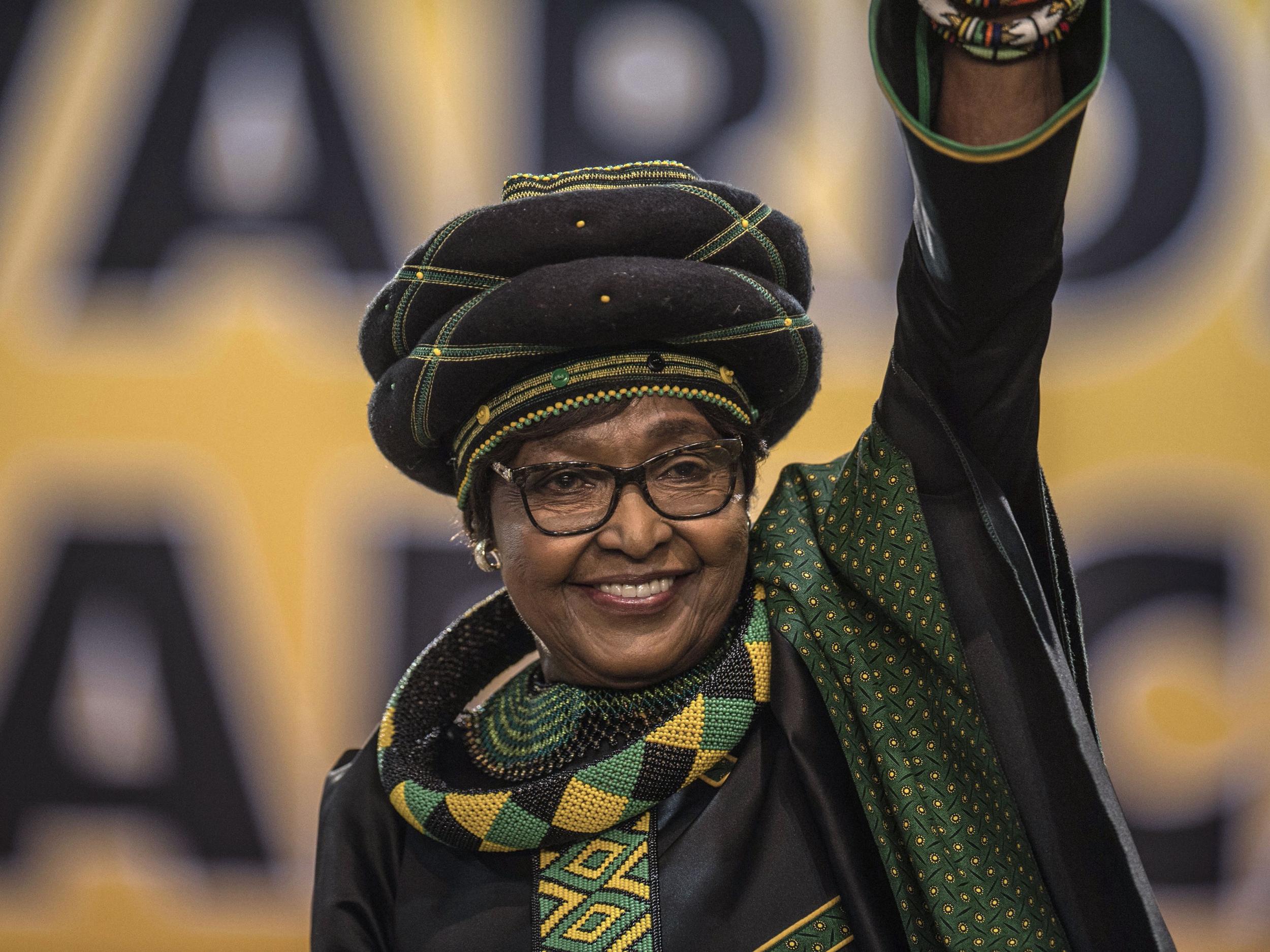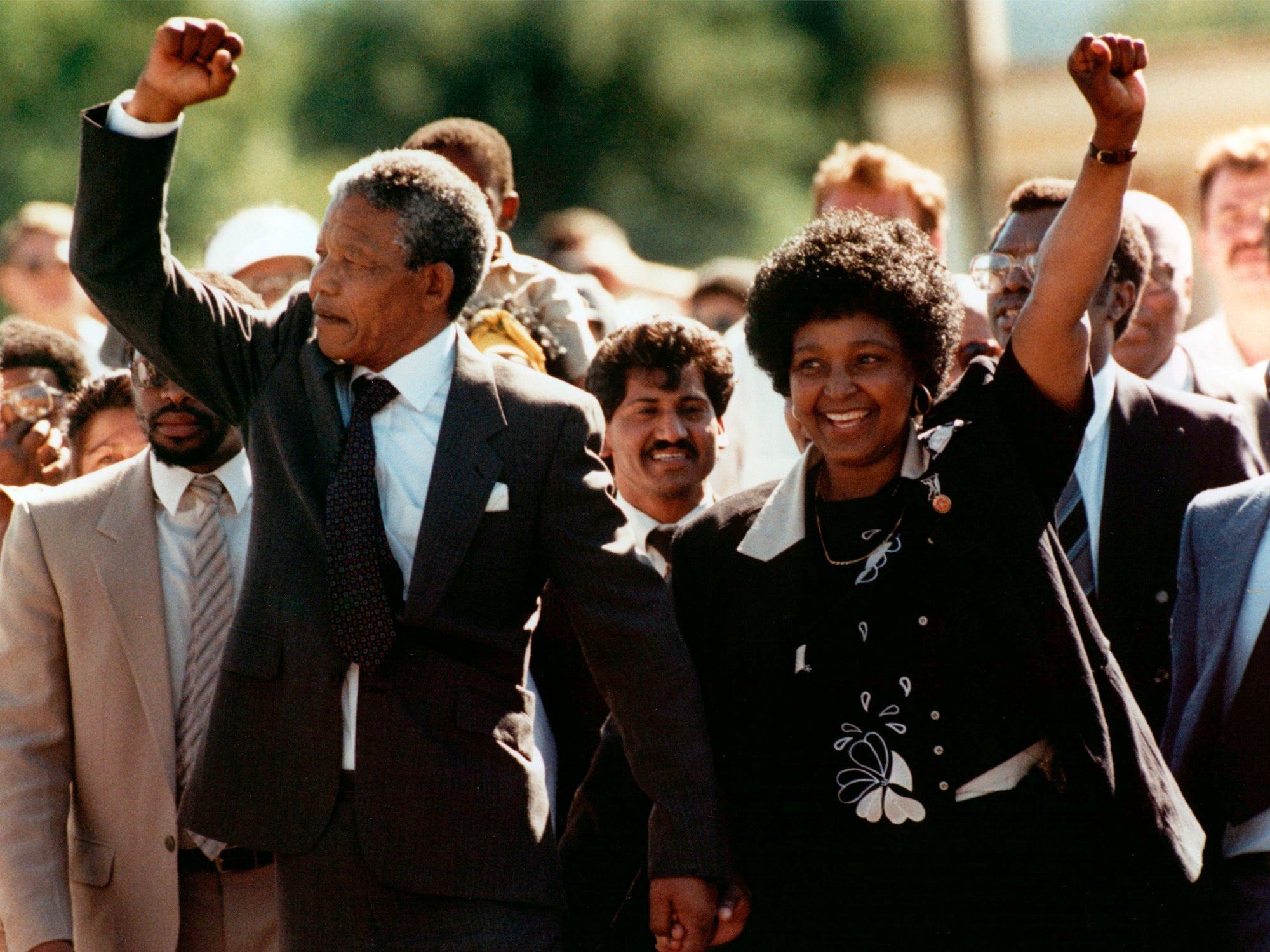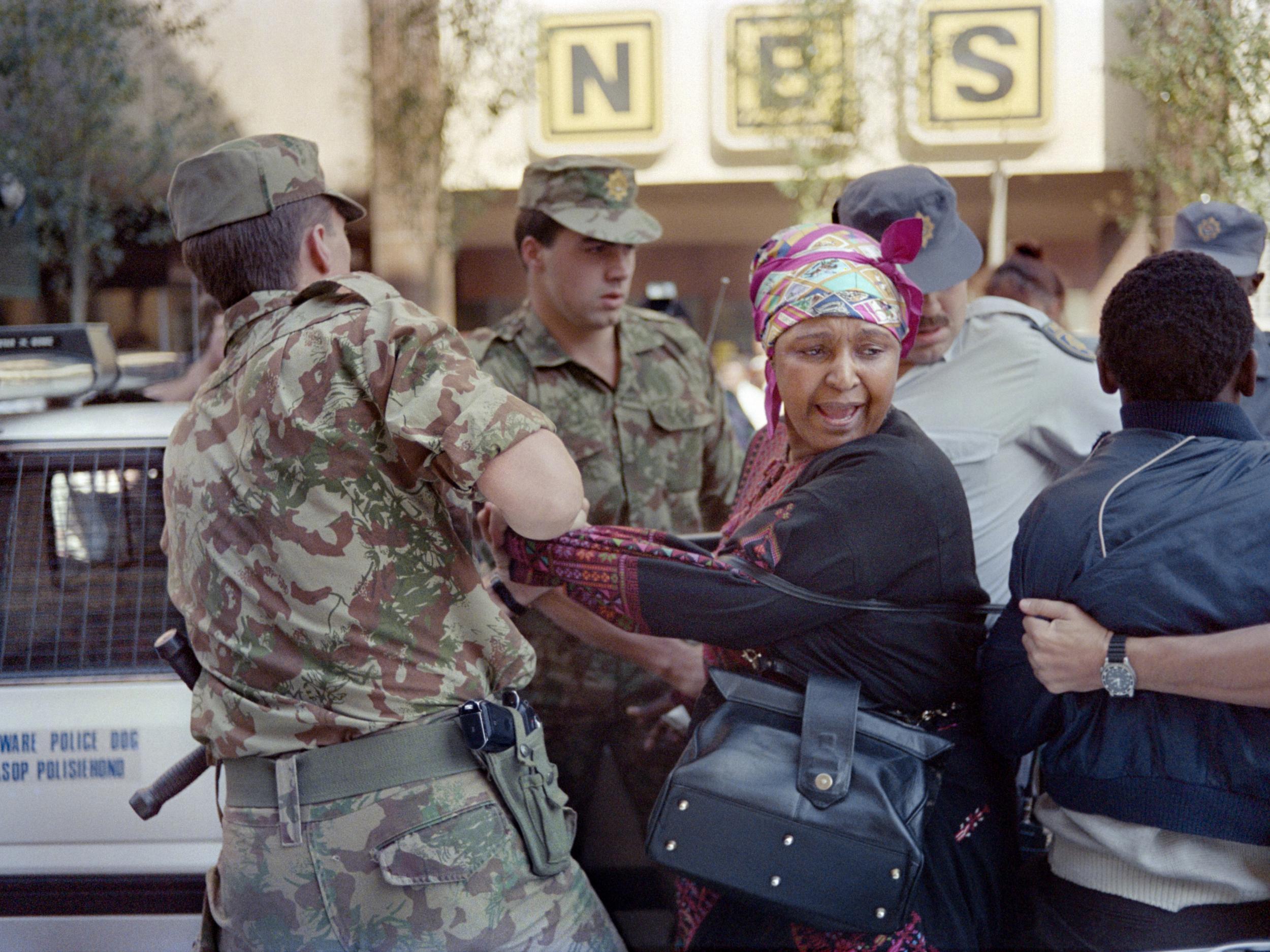Winnie Madikizela-Mandela: Tarnished leader of South Africa’s struggle to make apartheid history
Disgraced and corrupt, her behaviour was as baffling as it was dazzling in contrast to her former husband’s, whose integrity stood as a beacon to the world

Winnie Madikizela-Mandela was the former wife of Nelson Mandela and for decades one of South Africa’s most prominent and polarising figures. Long after her divorce from the country’s first democratically elected president, Madikizela-Mandela was still called the Mother of the Nation. And in many ways, she epitomised the “new” South Africa far more than her idealised former husband.
She was beautiful and violent. Her bravery under the brutal apartheid regime won her lasting respect and adulation; allegations that she was the kingpin of a deadly vigilante group during the 1980s earned her fear and mistrust. She was a political insider who often played the role of outsider. While other leaders moved to luxurious, previously all-white suburbs, Madikizela-Mandela stayed in Soweto, the black township southwest of Johannesburg.
She at times harshly criticised the African National Congress – the political party that she also called her “family” – most recently condemning it for the continued economic disparity that has left millions of black South Africans in poverty.
Yet since the end of apartheid in 1994, she served many roles in the South African government, from member of Parliament to the head of the ANC Women’s League. In the late 2000s, she emerged again as a leading political player. She was one of the top vote-getters to the ANC’s executive committee and in 2008 was listed in the fifth slot on the party’s parliamentary ticket – above many other senior politicians and cabinet members.
Fraud convictions, insubordination and allegations of crimes from corruption to murder all seemed, at different points, to spell her downfall. Yet Madikizela-Mandela always rebounded.
“I learned to deal with the police … to be tough … to survive,” she told a crowd at American University in 1996 after acknowledging that the world must be “puzzled” by stories of her. “I want you to know where I come from so you can tell where I am headed. I’m like thousands of women in South Africa who lost their men to cities and prisons … I stand defiant, tall and strong.”
Nomzamo Winifred Zanyiwe Madikizela was born in a remote, beautiful swath of South Africa called Pondoland in 1936.
Her father, Columbus, was a schoolteacher, and although he appreciated missionaries – especially the Germans, who inspired him to add the “Winifred” to his daughter’s name – he taught local children a different type of history.
“We had our textbooks, naturally written by white men, and they had their interpretation,” Madikizela-Mandela wrote in her 1984 autobiography, Part of My Soul Went with Him. “Then [Columbus] would put the textbook aside and say: ‘Now, this is what the book says, but the truth is: these white people invaded our country and stole the land from our grandfathers.’
“There is an anger that wakes up in you when you are a child and it builds up and determines the political consciousness of the black man,” she added.

Madikizela-Mandela put a more political spin on her childhood than did her teachers and schoolmates, who told biographer Emma Gilbey that they remembered “Winnie” more for her looks than her ideas.
But soon after Madikizela-Mandela obtained her social-work degree from the Jan Hofmeyr School in Johannesburg, she met Nelson Mandela. And then she became immersed in the resistance that would define modern-day South Africa.
Their first date was lunch at an Indian restaurant near Mandela’s law office. Sixteen years her senior, he was amused at her inability to eat the spicy curry. She sat silently, wearing an uncomfortable borrowed suit she hoped would make her look more sophisticated than her 23 years, as a slew of advice-seekers stopped to chat with her well-known date. Later, as they walked through the countryside, Nelson asked for her help raising funds. Her sandal broke on the rocky path.
“Politicians are not lovers,” she said in 1992, recollecting that first day together.
Yet the two developed what others described as a passionate relationship. They held hands in public; they went to jazz clubs. There was the occasional blazing argument – such as when Nelson tried to teach Winnie how to drive – but Nelson seemed amused by the young woman’s fire, Gilbey wrote.
Not a year after their first date, Nelson showed Winnie the house of a dressmaker and told her she should get fitted. He asked how many bridesmaids she would like to have, Madikizela-Mandela recalled in her autobiography.
“That’s how I was told I was getting married to him!” Madikizela-Mandela said. “I asked, ‘What time?’ I was madly in love with him.”
The couple lived within the struggle against the apartheid regime as it instituted ever more oppressive laws. Winnie’s first incarceration came in 1958, when she joined mass protests against laws that limited black women’s mobility.
She continued to battle the legal system for the rest of her life. The 1960 Sharpeville massacre, in which police killed dozens of unarmed protesters, focused the world’s attention on South Africa – and on the Mandelas.
At the time, Nelson Mandela was one of the defendants in what would become known as the Treason Trial – a long-running case against dozens of people involved in the public creation of the Freedom Charter, which was a blueprint for what participants hoped would be a future democratic South Africa.

Nelson Mandela, who was not incarcerated during most of the trial, was intimately involved in organising the group’s defence against allegations that it had plotted a violent overthrow of the government.
Although he had nothing to do with the violence at Sharpeville, Nelson Mandela was taken into custody soon after the massacre. Winnie – keen to give interviews – became his spokeswoman. Her role within the ANC began to shift from spouse to leader.
Although Nelson Mandela was found not guilty in 1961, he went into hiding soon thereafter. After he was captured and recharged, Winnie made front-page news when she arrived at her husband’s trial in traditional Tembu dress.
After he was sentenced to life in prison, she showed a brave face to the world, telling the BBC in a soft voice that she was relieved that her husband, the father of her two daughters, had not been sentenced to die. Her courage would be tested. Over the next years she would be arrested, harassed and “banned” – forbidden from most social contact. She was the target of police informers. Beginning in 1969, she spent 18 months in solitary confinement.
She was interrogated without break. She was forced to sit upright, for days and nights, to the point that her body swelled and she blacked out.
“My whole body was badly swollen, I was passing blood,” she wrote in her memoir. “The whole experience is so terrible, because I had left little children at home in bed and I had no idea what had happened to them.”
She was given food, but it was often served in unrinsed sanitary pail lids. Often the food was covered in bird droppings. She was contained by herself in a concrete cell, 5ft by 10ft; she slept on the floor. As the weeks passed, she became delirious.
Later, she was exiled to a shack in the remote town of Brandfort. Yet as the state increasingly isolated her, her international profile grew. The ANC leadership connected her with journalists who wrote about how she had started a day care and had taught other women to plant vegetable gardens. Less publicised was her alleged increased drinking and extramarital relationships, or the questions about what she did with all those international donations to her social welfare programmes in Brandfort.
“Our movement took a deliberate decision to profile Nelson Mandela as the representative personality of [political] prisoners, and therefore to use his personal biography, including the persecution of his then wife, Winnie Mandela, dramatically to present ... the brutality of the apartheid system,” former president Thabo Mbeki wrote soon after leaving office in 2008.
The ANC needed her, but also struggled to control her.
When a defiant Madikizela-Mandela returned to Soweto in 1985, it was a far more violent place than she had left, crawling with gangs and police brutality. Her rhetoric fit right in.
“We have no guns – we have only stones, boxes of matches and petrol,” she said at a rally in April 1986. “Together, hand in hand, with our boxes of matches and our necklaces, we shall liberate this country.”
“Necklacing” was a method of killing, often used against suspected police informants, in which a gasoline-soaked tyre was forced around someone’s body and then set alight. The speech caused an international outcry, particularly in western capitals.
The same year, she helped form the Mandela United Football Club. Instead of a sports team, many neighbours viewed Mandela United as Madikizela-Mandela’s personal gang. Soon, there were whispers of murders, abductions and hit lists.
Over New Year’s Eve, 1988-89, a 14-year-old named James Moeketsi Seipei, or “Stompie”, disappeared from her house. Although she forcefully denied involvement, others later testified that she ordered – and even took part in – the murder of the teen.
The ANC Crisis Committee wrote to their leaders in exile, asking how to manage “this new ghastly situation that is developing before our very eyes”.
When Nelson Mandela left prison in 1990, Winnie was there, brilliant before the cameras; one hand in her husband’s, the other held aloft in a fist. But she was soon charged in connection with Stompie’s murder. Although witnesses disappeared, she was convicted of kidnapping and being an accessory to assault.
She never went to jail for the Stompie case. She appealed, and in June 1993 the court upheld her kidnapping conviction but overturned the accessory to assault conviction. Her sentence was suspended and she was ordered to pay a fine.
Nelson continued to support his wife publicly, but rumours suggested all was not well in the Mandela marriage. In 1992, Nelson announced their separation. He was pained but gracious.
“She endured the persecutions heaped upon her by the government with exemplary fortitude and never wavered from her commitment to the struggle for freedom,” he said. “Her tenacity reinforced my personal respect, love and growing affection.”
Four years later, suing Winnie for divorce, he was less generous. When he emerged after 27 years in prison, he said, the woman he once called his “darling” had changed. She was blatant in her infidelity, he added, and cold. “I was the loneliest man during the time I stayed with her,” he said.
The judge granted the divorce, over Winnie’s protests. In 1998, the country’s Truth and Reconciliation Commission, chaired by Archbishop Desmond Tutu, condemned her for human rights violations after evidence from 30 witnesses. Its final report read: “The commission finds that Ms Madikizela-Mandela was central to the establishment and formation of the Mandela United Football Club, which later developed into a private vigilante unit.”
It continued: “The commission finds that those who opposed Ms Madikizela-Mandela and the Mandela United Football Club, or dissented from them, were branded as informers and killed. The commission finds that Ms Madikizela-Mandela ... is accountable, politically and morally, for the gross violations of human rights committed by the Mandela United Football Club.
“The commission finds further that Ms Madikizela-Mandela herself was responsible for committing such gross violations of human rights.”
She only apologised after an emotional plea from Tutu during the hearings. But her followers – and her party – seemed to forgive, or ignore, these alleged trespasses.
She headed the ANC’s Women’s League and ran for deputy president, but resigned from all leadership positions after being found guilty in 2003 of fraud and theft in connection to a bank scam. In the late 2000s, she emerged again as one of the country’s most popular politicians. The country’s youth continued to call her their hero, and government officials said the ANC would “never turn its back on Winnie”.
“Without condoning her misdemeanors, we must acknowledge that she is a victim, she is damaged and hurt,” said future South African president Kgalema Motlanthe, who at the time was ANC secretary general. “When someone is subjected to the kind of consistent persecution and harassment she suffered from the apartheid system, something is bound to snap. We understand that and will always be there for her.”
Winnie Madikizela-Mandela, South African anti-apartheid activist and politician, born 26 September 1936, died 2 April 2018
© Washington Post
Join our commenting forum
Join thought-provoking conversations, follow other Independent readers and see their replies
Comments